A Million-Cow Genome-Wide Association Study of Three Fertility Traits in U.S. Holstein Cows
Abstract
1. Introduction
2. Results and Discussion
2.1. Additive Effects for DPR
2.2. Dominance Effects for DPR
2.3. Additive Effects for CCR
2.4. Dominance Effects for CCR
2.5. Additive Effects for HCR
2.6. Common Effects for DPR, CCR, and HCR
2.7. Dominance Effects for HCR
2.8. Elimination of Rare Negative Recessive Genotypes for Heifer Culling
2.9. Interpretation of Dominance Effects
2.10. Statistical Significance, Effect Size, and Frequency
2.11. Comparison between the 2023 and 2019 Studies
2.12. Gene Ontology of Candidate Genes
3. Materials and Methods
3.1. Holstein Population and SNP Data
3.2. GWAS Analysis
4. Conclusions
Supplementary Materials
Author Contributions
Funding
Institutional Review Board Statement
Informed Consent Statement
Data Availability Statement
Acknowledgments
Conflicts of Interest
Appendix A

Appendix B
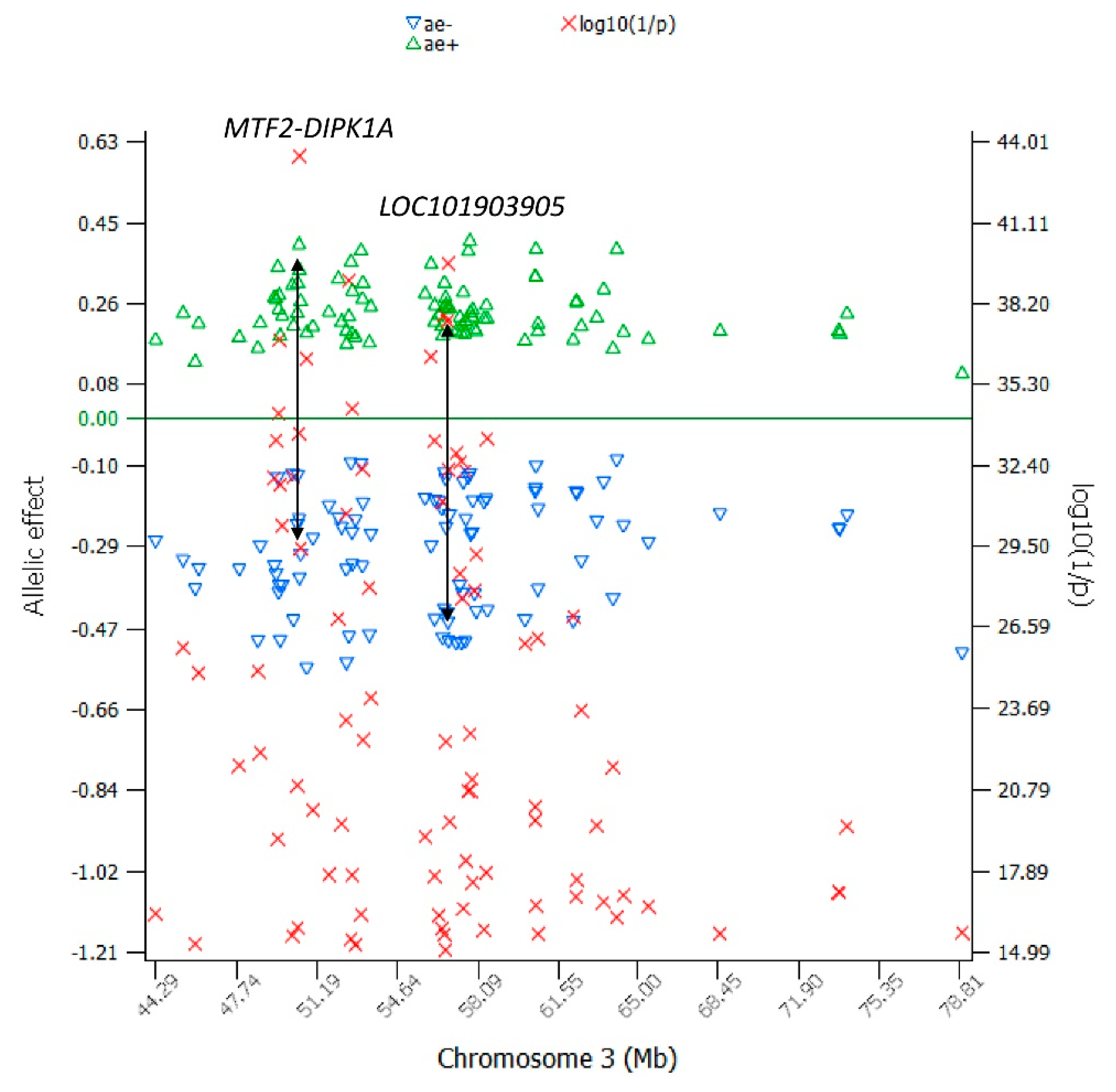
Appendix C
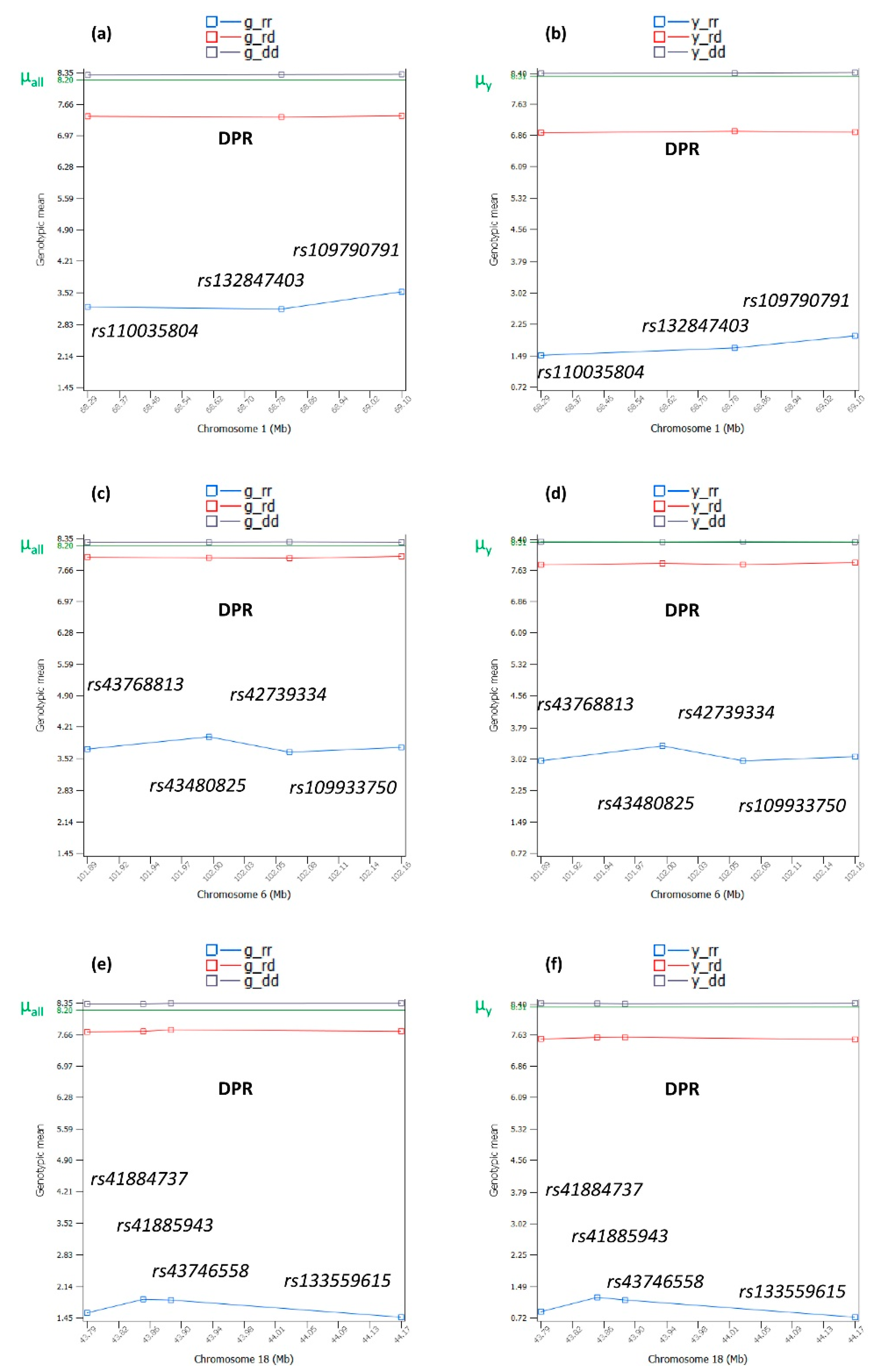
References
- VanRaden, P.; Sanders, A.; Tooker, M.; Miller, R.; Norman, H.; Kuhn, M.; Wiggans, G. Development of a national genetic evaluation for cow fertility. J. Dairy Sci. 2004, 87, 2285–2292. [Google Scholar] [CrossRef] [PubMed]
- CDCB. Individual Traits. Available online: https://uscdcb.com/individual-traits/ (accessed on 12 June 2023).
- Ma, L.; Cole, J.; Da, Y.; VanRaden, P. Symposium review: Genetics, genome-wide association study, and genetic improvement of dairy fertility traits. J. Dairy Sci. 2018, 102, 3735–3743. [Google Scholar] [CrossRef] [PubMed]
- Gaddis, K.P.; Null, D.; Cole, J. Explorations in genome-wide association studies and network analyses with dairy cattle fertility traits. J. Dairy Sci. 2016, 99, 6420–6435. [Google Scholar] [CrossRef] [PubMed]
- Jiang, J.; Shen, B.; O’Connell, J.R.; VanRaden, P.M.; Cole, J.B.; Ma, L. Dissection of additive, dominance, and imprinting effects for production and reproduction traits in Holstein cattle. BMC Genom. 2017, 18, 425. [Google Scholar] [CrossRef] [PubMed]
- VanRaden, P.; Cole, J.; Gaddis, K.P. Net merit as a measure of lifetime profit: 2014 revision. AIP Res. Rep. 2014, 7, 5–18. [Google Scholar]
- Jiang, J.; Cole, J.B.; Freebern, E.; Da, Y.; VanRaden, P.M.; Ma, L. Functional annotation and Bayesian fine-mapping reveals candidate genes for important agronomic traits in Holstein bulls. Commun. Biol. 2019, 2, 212. [Google Scholar] [CrossRef] [PubMed]
- Jiang, J.; Ma, L.; Prakapenka, D.; VanRaden, P.M.; Cole, J.B.; Da, Y. A large-scale genome-wide association study in US Holstein cattle. Front. Genet. 2019, 10, 412. [Google Scholar] [CrossRef] [PubMed]
- Prakapenka, D.; Liang, Z.; Da, Y. Genome-wide association study of age at first calving in US Holstein cows. Int. J. Mol. Sci. 2023, 24, 7109. [Google Scholar] [CrossRef] [PubMed]
- SHBG Sex Hormone Binding Globulin. The National Center for Biotechnology Information. Available online: https://www.ncbi.nlm.nih.gov/gene/6462 (accessed on 12 June 2023).
- Aydın, B.; Winters, S.J. Sex hormone-binding globulin in children and adolescents. J. Clin. Res. Pediatr. Endocrinol. 2016, 8, 1–12. [Google Scholar] [CrossRef] [PubMed]
- Valsamakis, G.; Violetis, O.; Chatzakis, C.; Triantafyllidou, O.; Eleftheriades, M.; Lambrinoudaki, I.; Mastorakos, G.; Vlahos, N.F. Daughters of polycystic ovary syndrome pregnancies and androgen levels in puberty: A Meta-analysis. Gynecol. Endocrinol. 2022, 38, 822–830. [Google Scholar] [CrossRef] [PubMed]
- GNRHR Gonadotropin Releasing Hormone Receptor. The National Center for Biotechnology Information. Available online: https://www.ncbi.nlm.nih.gov/gene/2798 (accessed on 12 June 2023).
- ESR1 Estrogen Receptor 1. The National Center for Biotechnology Information. Available online: https://www.ncbi.nlm.nih.gov/gene/2099 (accessed on 12 June 2023).
- Reese, S.; Geary, T.; Franco, G.; Moraes, J.; Spencer, T.; Pohler, K. Pregnancy associated glycoproteins (PAGs) and pregnancy loss in high vs sub fertility heifers. Theriogenology 2019, 135, 7–12. [Google Scholar] [CrossRef] [PubMed]
- The Gene Ontology Resource. Available online: http://geneontology.org/ (accessed on 12 June 2023).
- VanRaden, P.M.; Sun, C.; O’Connell, J.R. Fast imputation using medium or low-coverage sequence data. BMC Genet. 2015, 16, 1–12. [Google Scholar] [CrossRef] [PubMed]
- CDCB. Genomic Evaluations. Available online: https://uscdcb.com/genomic-evaluations/ (accessed on 12 June 2023).
- Wiggans, G.; VanRaden, P.; Cooper, T. The genomic evaluation system in the United States: Past, present, future. J. Dairy Sci. 2011, 94, 3202–3211. [Google Scholar] [CrossRef] [PubMed]
- CDCB. QC Metrics for Genotyping Laboratories. Available online: https://redmine.uscdcb.com/projects/cdcb-customer-service/wiki/QC_Metrics_for_Genotyping_Laboratories (accessed on 12 June 2023).
- National Library of Medicine (NCBI). Available online: https://www.ncbi.nlm.nih.gov/genome/82?genome_assembly_id=1850378 (accessed on 12 June 2023).
- Wang, S.; Dvorkin, D.; Da, Y. SNPEVG: A graphical tool for GWAS graphing with mouse clicks. BMC Bioinform. 2012, 13, 319. [Google Scholar] [CrossRef] [PubMed]
- Ma, L.; Runesha, H.B.; Dvorkin, D.; Garbe, J.; Da, Y. Parallel and serial computing tools for testing single-locus and epistatic SNP effects of quantitative traits in genome-wide association studies. BMC Bioinform. 2008, 9, 315. [Google Scholar] [CrossRef] [PubMed]
- Weeks, N.T.; Luecke, G.R.; Groth, B.M.; Kraeva, M.; Ma, L.; Kramer, L.M.; Koltes, J.E.; Reecy, J.M. High-performance epistasis detection in quantitative trait GWAS. Int. J. High Perform. Comput. Appl. 2016, 32, 1094342016658110. [Google Scholar] [CrossRef]
- Henderson, C. Applications of Linear Models in Animal Breeding; University of Guelph: Guelph, Ontario, 1984. [Google Scholar]
- Mao, Y.; London, N.R.; Ma, L.; Dvorkin, D.; Da, Y. Detection of SNP epistasis effects of quantitative traits using an extended Kempthorne model. Physiol. Genom. 2006, 28, 46–52. [Google Scholar] [CrossRef] [PubMed]
- Falconer, D.S.; Mackay, T.F.C. Introduction to Quantitative Genetics, 4th ed.; Longmans Green: Harlow, UK, 1996. [Google Scholar]
- Ensembl Genome Browzer 109. Available online: https://useast.ensembl.org/index.html (accessed on 12 June 2023).
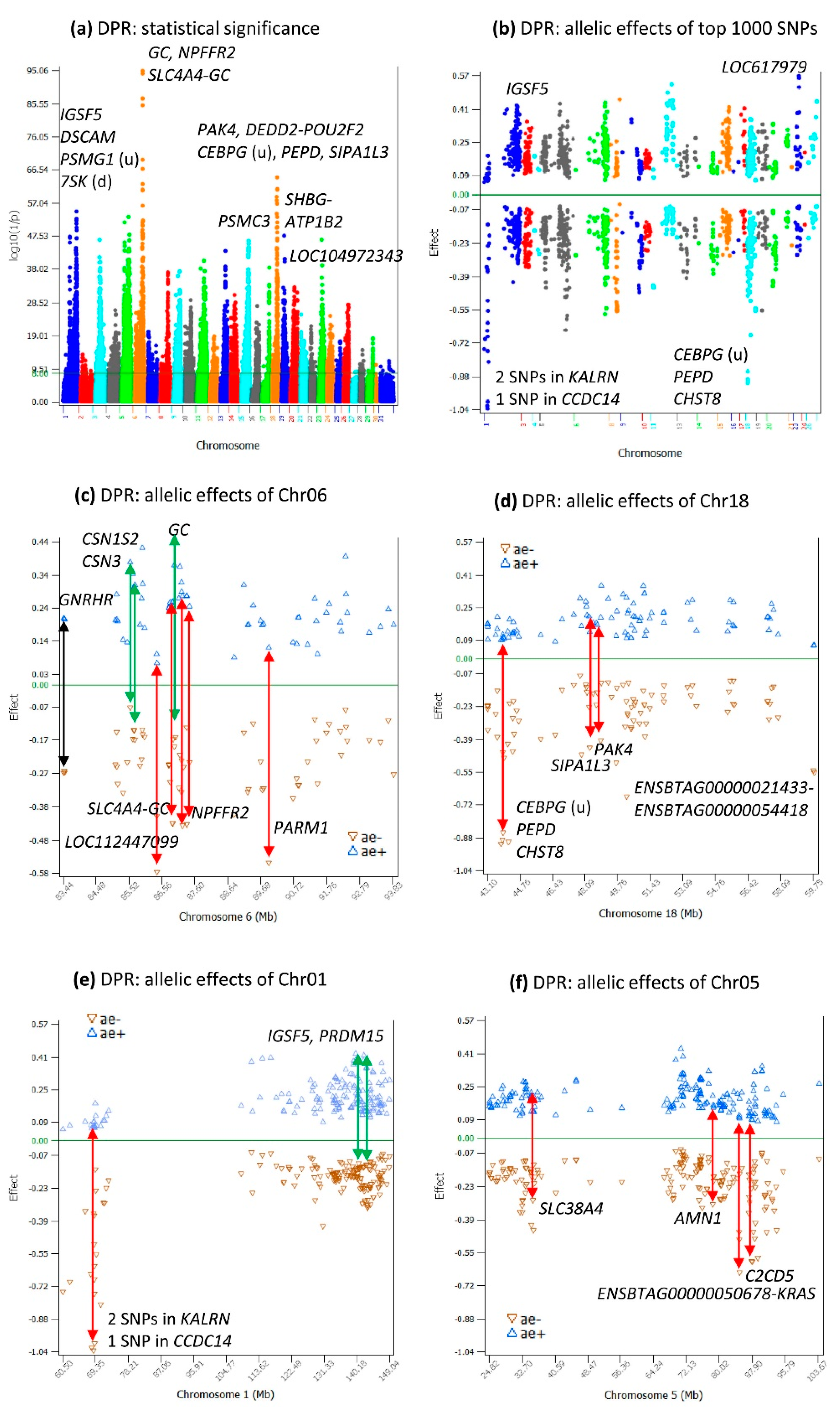
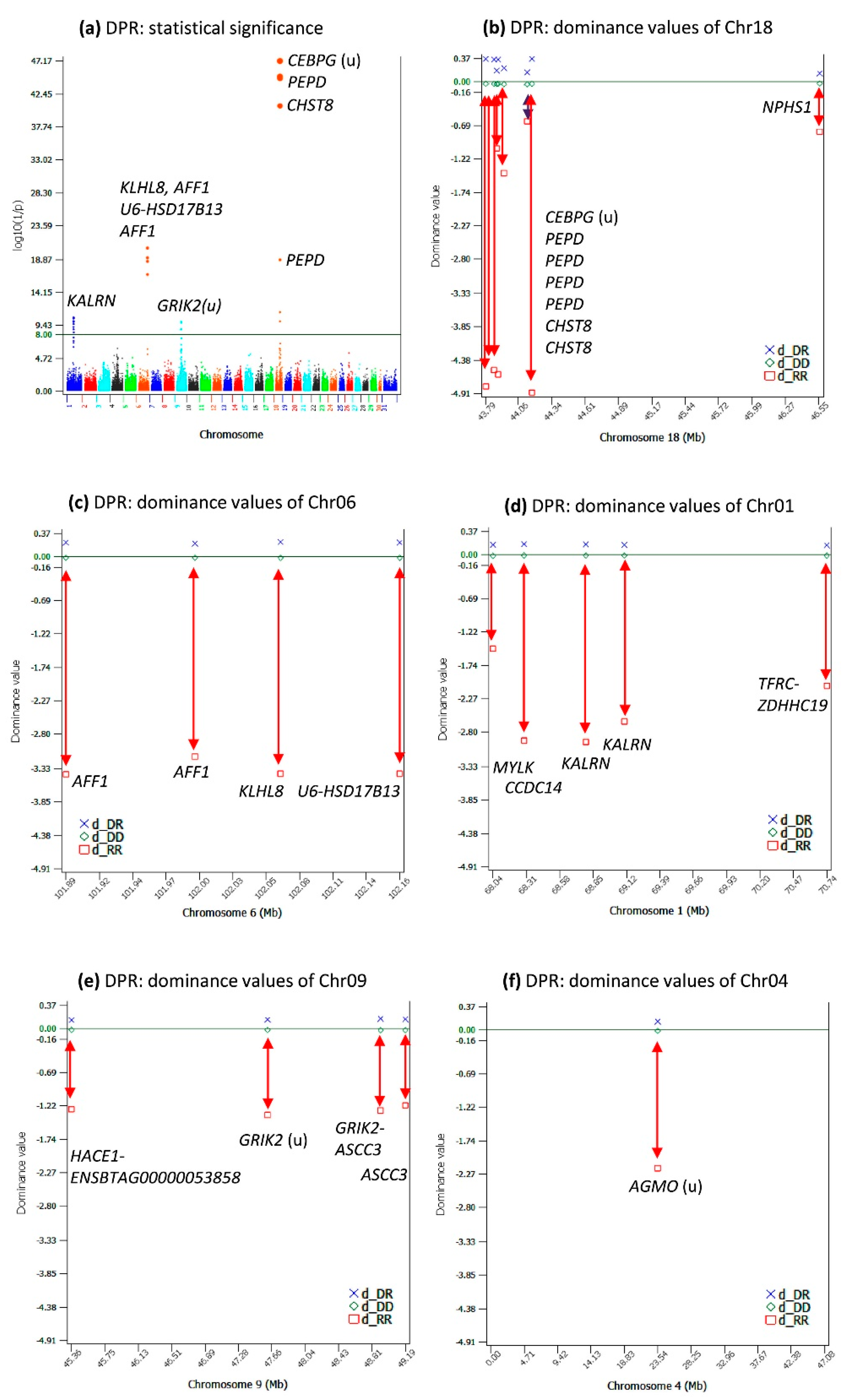
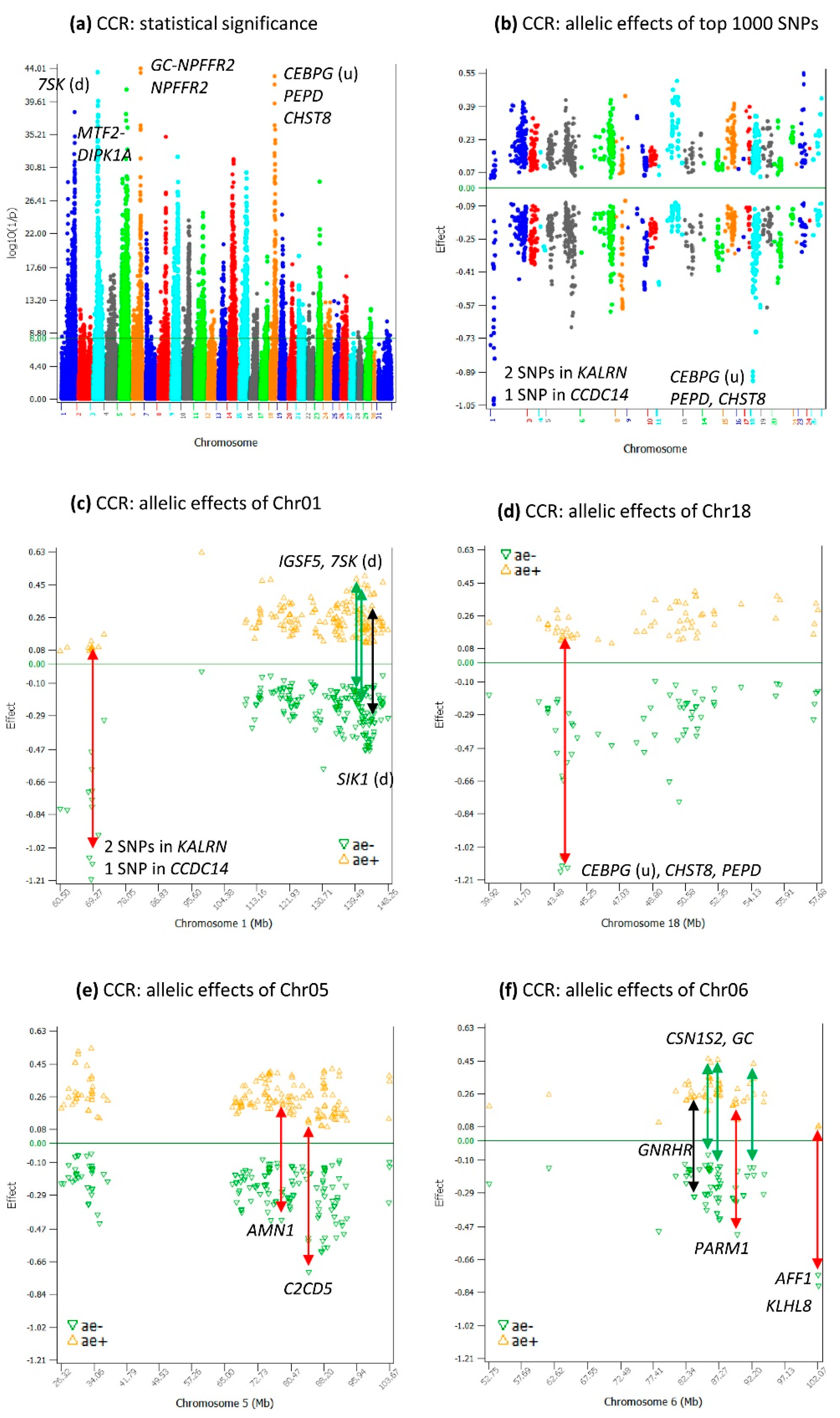
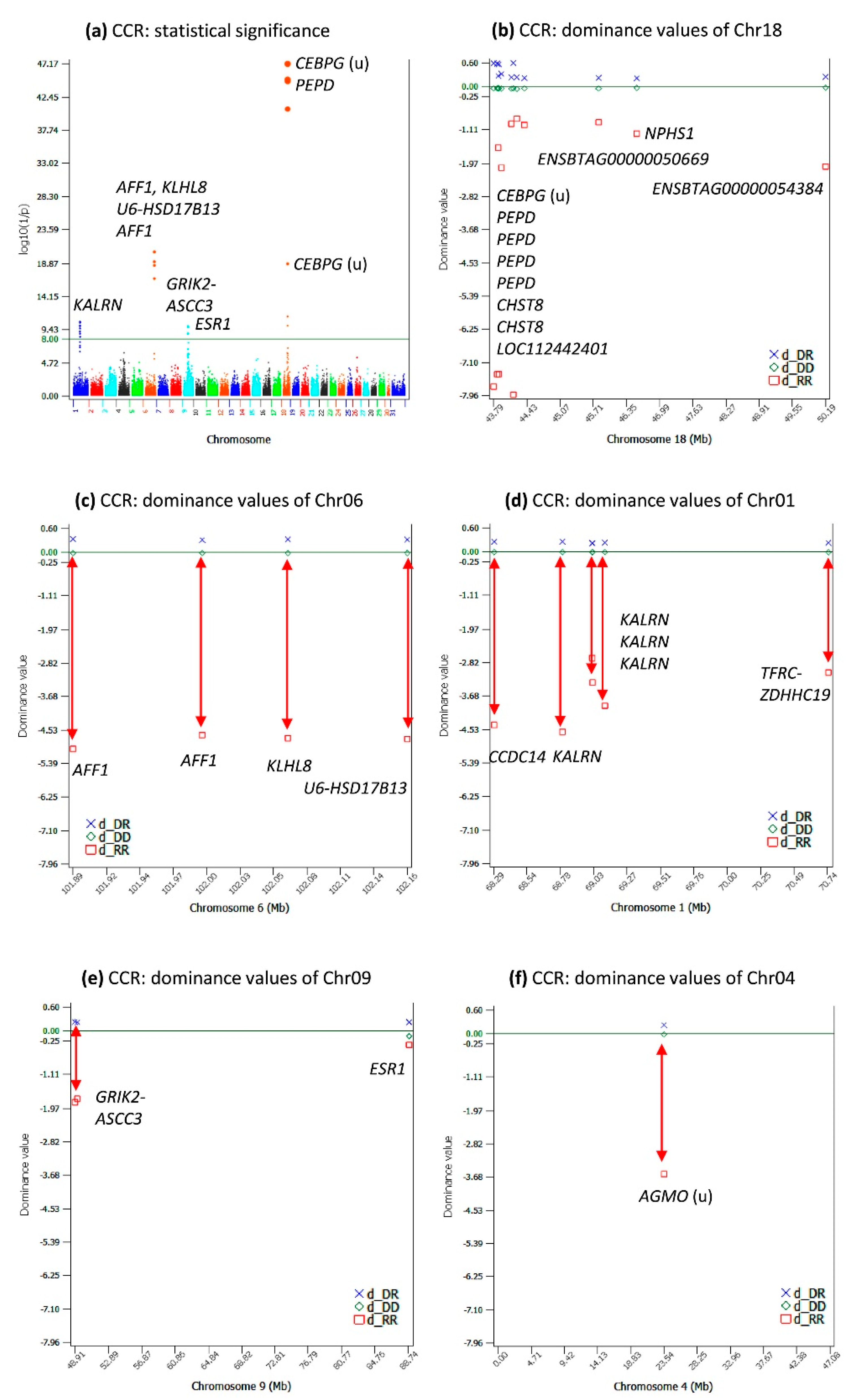



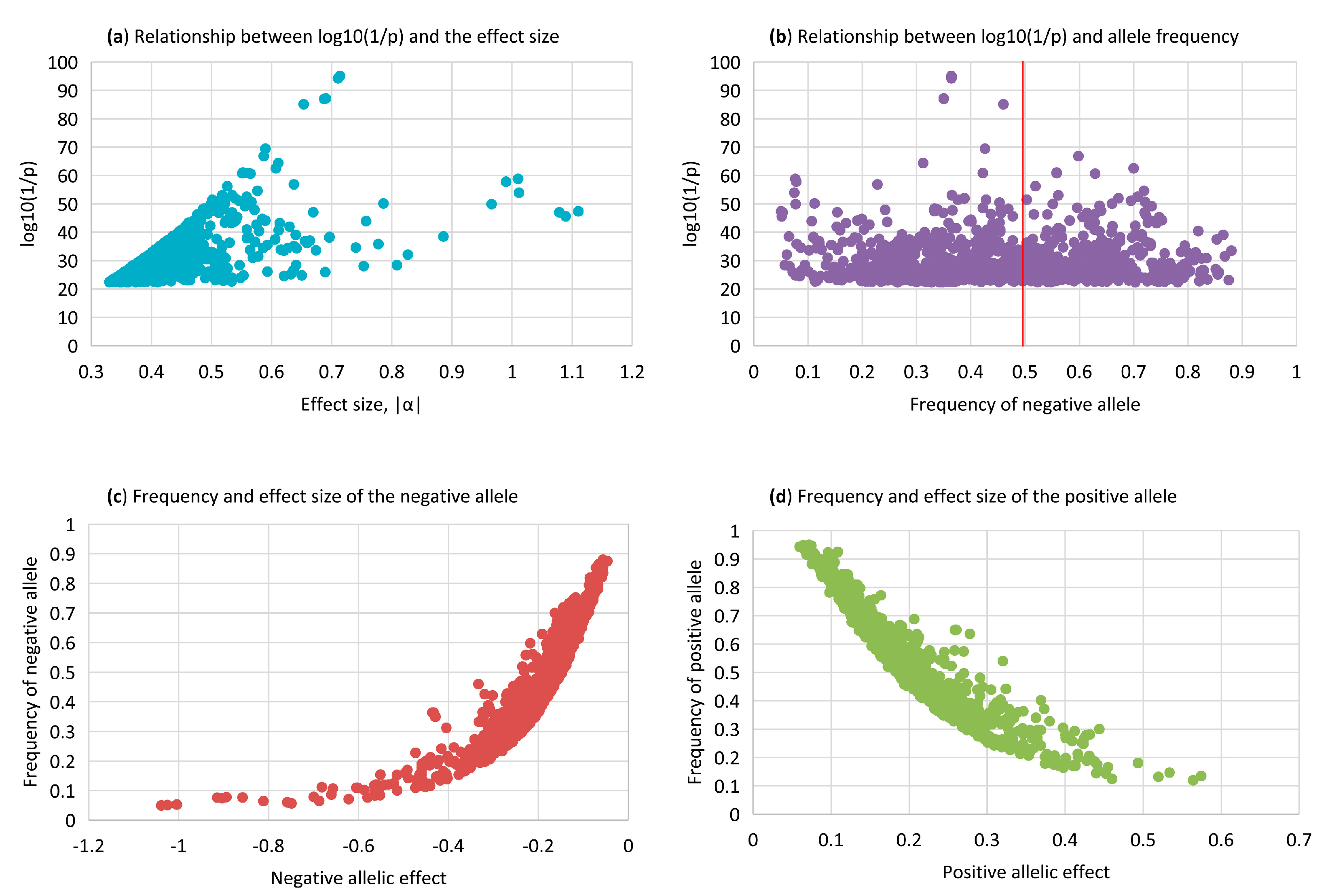
| SNP | Chr | Position | Candidate Gene | α | al+ | ae+ | f_al+ | al− | ae− | f_al− | log10(1/p) |
|---|---|---|---|---|---|---|---|---|---|---|---|
| rs110434046 | 6 | 87184768 | GC-NPFFR2 | −0.714 | 2 | 0.260 | 0.636 | 1 | −0.454 | 0.364 | 95.06 |
| rs109034709 | 6 | 87316810 | NPFFR2 | −0.711 | 2 | 0.258 | 0.636 | 1 | −0.452 | 0.364 | 94.27 |
| rs110380398 | 6 | 86877334 | SLC4A4-GC | 0.690 | 1 | 0.242 | 0.650 | 2 | −0.448 | 0.350 | 87.16 |
| rs110527224 | 6 | 86860291 | SLC4A4-GC | −0.687 | 2 | 0.241 | 0.650 | 1 | −0.447 | 0.350 | 87.00 |
| rs137147462 | 6 | 87153414 | GC-NPFFR2 | −0.653 | 2 | 0.301 | 0.540 | 1 | −0.353 | 0.460 | 85.12 |
| rs109452259 | 6 | 87068809 | GC-NPFFR2 | 0.590 | 1 | 0.251 | 0.574 | 2 | −0.338 | 0.426 | 69.45 |
| rs42767507 | 6 | 87101644 | GC-NPFFR2 | −0.587 | 2 | 0.351 | 0.402 | 1 | −0.236 | 0.598 | 66.81 |
| rs210926829 | 18 | 48869465 | PAK4 | 0.611 | 1 | 0.191 | 0.688 | 2 | −0.42 | 0.312 | 64.40 |
| rs134342291 | 6 | 86964714 | GC | 0.607 | 1 | 0.425 | 0.300 | 2 | −0.182 | 0.700 | 62.52 |
| rs41635776 | 18 | 51084210 | DEDD2-POU2F2 | −0.552 | 2 | 0.308 | 0.442 | 1 | −0.244 | 0.558 | 61.02 |
| rs137664040 | 6 | 86795926 | SLC4A4 | −0.560 | 2 | 0.236 | 0.578 | 1 | −0.324 | 0.422 | 60.86 |
| rs110682631 | 18 | 51107045 | DEDD2-POU2F2 | −0.551 | 2 | 0.307 | 0.442 | 1 | −0.244 | 0.558 | 60.82 |
| rs43338539 | 6 | 86924174 | SLC4A4-GC | 0.565 | 1 | 0.355 | 0.371 | 2 | −0.21 | 0.629 | 60.63 |
| rs41884737 | 18 | 43786051 | CEBPG (u) | 1.010 | 1 | 0.077 | 0.923 | 2 | −0.933 | 0.077 | 58.80 |
| rs41885943 | 18 | 43854199 | PEPD | 0.990 | 1 | 0.078 | 0.922 | 2 | −0.912 | 0.078 | 57.79 |
| rs109972395 | 18 | 47886323 | SIPA1L3 | −0.637 | 2 | 0.145 | 0.772 | 1 | −0.492 | 0.228 | 56.86 |
| rs42766480 | 6 | 87156735 | GC-NPFFR2 | 0.526 | 1 | 0.273 | 0.481 | 2 | −0.253 | 0.519 | 56.23 |
| rs43275844 | 1 | 139828817 | IGSF5 | −0.576 | 2 | 0.414 | 0.281 | 1 | −0.162 | 0.719 | 54.59 |
| rs43746558 | 18 | 44167440 | CHST8 | 1.012 | 1 | 0.076 | 0.925 | 2 | −0.936 | 0.075 | 53.94 |
| rs109118753 | 5 | 78228782 | AMN1 | −0.534 | 2 | 0.195 | 0.635 | 1 | −0.339 | 0.365 | 53.02 |
| SNP | Chr | Position | Candidate Gene | δ | DR | d_DR | f_DR | DD | d_DD | f_DD | RR | d_RR | f_RR | log10(1/p) |
|---|---|---|---|---|---|---|---|---|---|---|---|---|---|---|
| rs41884737 a | 18 | 43786051 | CEBPG (u) | 2.78 | 12 | 0.365 | 0.142 | 11 | −0.030 | 0.852 | 22 | −4.81 | 0.005 | 59.30 |
| rs41885943 a | 18 | 43854199 | PEPD | 2.64 | 12 | 0.355 | 0.145 | 11 | −0.030 | 0.849 | 22 | −4.55 | 0.006 | 56.09 |
| rs43746558 a | 18 | 44167440 | CHST8 | 2.84 | 12 | 0.366 | 0.139 | 11 | −0.029 | 0.856 | 22 | −4.91 | 0.005 | 55.36 |
| rs133443778 a | 18 | 43887966 | PEPD | 2.68 | 12 | 0.354 | 0.143 | 11 | −0.029 | 0.851 | 22 | −4.62 | 0.006 | 51.30 |
| rs42739334 | 6 | 102065812 | KLHL8 | 1.95 | 12 | 0.235 | 0.123 | 11 | −0.016 | 0.873 | 22 | −3.42 | 0.004 | 23.13 |
| rs109933750 | 6 | 102164971 | KLHL8-HSD17B13 | 1.95 | 12 | 0.226 | 0.121 | 22 | −0.016 | 0.875 | 11 | −3.42 | 0.004 | 22.00 |
| rs43768813 | 6 | 101887271 | AFF1 | 1.95 | 12 | 0.227 | 0.119 | 22 | −0.015 | 0.877 | 11 | −3.43 | 0.004 | 21.76 |
| rs43480825 | 6 | 101994654 | AFF1 | 1.79 | 12 | 0.210 | 0.122 | 11 | −0.015 | 0.874 | 22 | −3.15 | 0.004 | 19.07 |
| rs110035804 | 1 | 68293671 | CCDC14 | 1.64 | 12 | 0.170 | 0.097 | 11 | −0.009 | 0.900 | 22 | −2.93 | 0.003 | 10.76 |
| rs132847403 | 1 | 68792344 | KALRN | 1.64 | 12 | 0.167 | 0.095 | 11 | −0.009 | 0.902 | 22 | −2.95 | 0.003 | 10.59 |
| rs111023007 | 4 | 23542497 | AGMO (u) | 1.23 | 12 | 0.137 | 0.139 | 11 | −0.011 | 0.856 | 22 | −2.18 | 0.004 | 9.94 |
| rs109790791 | 1 | 69102381 | KALRN | 1.48 | 12 | 0.158 | 0.100 | 11 | −0.009 | 0.897 | 22 | −2.63 | 0.003 | 9.48 |
| rs137814900 | 1 | 70735271 | TFRC-ZDHHC19 | 1.19 | 12 | 0.154 | 0.121 | 11 | −0.011 | 0.875 | 22 | −2.07 | 0.004 | 9.02 |
| SNP | Chr | Position | Candidate Gene | α | al+ | ae+ | f_al+ | al− | ae− | f_al− | log10(1/p) |
|---|---|---|---|---|---|---|---|---|---|---|---|
| rs41911772 | 19 | 34170903 | EPN2-GRAP | 0.606 | 1 | 0.174 | 0.714 | 2 | −0.433 | 0.286 | 27.92 |
| rs42739334 | 6 | 102065812 | KLHL8 | 1.026 | 1 | 0.064 | 0.938 | 2 | −0.962 | 0.062 | 22.65 |
| rs135712994 | 19 | 33421057 | NCOR1 | −0.502 | 2 | 0.182 | 0.638 | 1 | −0.320 | 0.362 | 21.71 |
| rs110569179 | 19 | 34245953 | SLC5A10-FAM83G | 0.493 | 1 | 0.214 | 0.565 | 2 | −0.279 | 0.435 | 21.63 |
| rs43480825 | 6 | 101994654 | AFF1 | 0.989 | 1 | 0.061 | 0.938 | 2 | −0.928 | 0.062 | 21.07 |
| rs110761858 | 19 | 33358794 | NCOR1 | −0.489 | 2 | 0.179 | 0.633 | 1 | −0.310 | 0.367 | 20.85 |
| rs134340085 | 19 | 28503389 | NTN1 | 0.516 | 1 | 0.154 | 0.701 | 2 | −0.362 | 0.299 | 20.56 |
| rs43768813 | 6 | 101887271 | AFF1 | −0.985 | 2 | 0.060 | 0.939 | 1 | −0.925 | 0.061 | 20.56 |
| rs109547103 | 19 | 30101489 | ENSBTAG00000049618 | 0.513 | 1 | 0.142 | 0.723 | 2 | −0.371 | 0.277 | 19.65 |
| rs109933750 | 6 | 102164971 | HSD17B13 (u) | −0.942 | 2 | 0.058 | 0.939 | 1 | −0.884 | 0.061 | 18.97 |
| rs109086091 | 19 | 31844296 | HS3ST3A1-COX10 | −0.483 | 2 | 0.159 | 0.671 | 1 | −0.324 | 0.329 | 18.97 |
| rs29015945 | 19 | 35808547 | SPAG9 (d) | 0.452 | 1 | 0.191 | 0.577 | 2 | −0.261 | 0.423 | 18.67 |
| rs135166134 | 19 | 31231460 | ARHGAP44 | −0.450 | 2 | 0.220 | 0.510 | 1 | −0.229 | 0.490 | 18.15 |
| rs41641007 | 19 | 26224813 | RABEP1 | −0.463 | 2 | 0.157 | 0.661 | 1 | −0.306 | 0.339 | 17.94 |
| rs3423456831 | 19 | 26278782 | LOC101904050 | 0.639 | 1 | 0.554 | 0.133 | 2 | −0.085 | 0.867 | 17.30 |
| rs133654564 | 19 | 31638013 | HS3ST3A1 (u) | −0.584 | 2 | 0.100 | 0.829 | 1 | −0.484 | 0.171 | 17.29 |
| rs110940549 | 19 | 33716989 | SPECC1 | 0.520 | 1 | 0.113 | 0.782 | 2 | −0.406 | 0.218 | 17.25 |
| rs3423444153 | 19 | 31479267 | HS3ST3A1 (u) | 0.434 | 1 | 0.221 | 0.491 | 2 | −0.213 | 0.509 | 17.20 |
| rs3423447585 | 19 | 31166010 | MYOCD | −0.435 | 2 | 0.179 | 0.588 | 1 | −0.256 | 0.412 | 17.15 |
| rs3423293217 | 9 | 70653077 | blank | −0.444 | 2 | 0.279 | 0.371 | 1 | −0.165 | 0.629 | 16.80 |
| SNP | Chr | Position | Candidate Gene | δ | DR | d_DR | f_DR | DD | d_DD | f_DD | RR | d_RR | f_RR | log10(1/p) |
|---|---|---|---|---|---|---|---|---|---|---|---|---|---|---|
| rs111023007 a | 4 | 23542497 | AGMO (u) | 4.20 | 12 | 0.535 | 0.147 | 11 | −0.046 | 0.848 | 22 | −7.29 | 0.005 | 60.90 |
| rs29023731 a | 4 | 23863959 | AGMO | 3.70 | 12 | 0.491 | 0.153 | 22 | −0.044 | 0.841 | 11 | −6.37 | 0.006 | 51.25 |
| rs136006978 | 4 | 28692421 | TMEM196-MACC1 | 1.61 | 12 | 0.378 | 0.256 | 11 | −0.066 | 0.724 | 22 | −2.41 | 0.020 | 28.37 |
| rs42269361 | 4 | 27587323 | HDAC9 | 1.62 | 12 | 0.376 | 0.239 | 22 | −0.061 | 0.742 | 11 | −2.42 | 0.019 | 26.87 |
| rs42739334 a | 6 | 102065812 | KLHL8 | 3.31 | 12 | 0.376 | 0.116 | 11 | −0.025 | 0.88 | 22 | −5.84 | 0.004 | 26.75 |
| rs43480825 a | 6 | 101994654 | AFF1 | 3.34 | 12 | 0.37 | 0.116 | 11 | −0.024 | 0.88 | 22 | −5.91 | 0.004 | 26.71 |
| rs43768813 a | 6 | 101887271 | AFF1 | 3.35 | 12 | 0.373 | 0.114 | 22 | −0.024 | 0.882 | 11 | −5.93 | 0.004 | 26.46 |
| rs109933750 a | 6 | 102164971 | KLHL8-HSD17B13 | 3.33 | 12 | 0.368 | 0.115 | 22 | −0.024 | 0.881 | 11 | −5.90 | 0.004 | 26.23 |
| rs42910197 | 4 | 34161540 | LOC101904927 | 1.91 | 12 | 0.344 | 0.201 | 22 | −0.043 | 0.788 | 11 | −3.09 | 0.011 | 24.65 |
| rs42598643 | 4 | 24012373 | MEOX2 | 1.36 | 12 | 0.311 | 0.244 | 11 | −0.051 | 0.738 | 22 | −2.04 | 0.019 | 19.11 |
| rs43377794 | 4 | 28307693 | FERD3L-POLR1F | 1.04 | 12 | 0.288 | 0.294 | 22 | −0.062 | 0.677 | 11 | −1.44 | 0.030 | 16.51 |
| rs110248417 | 8 | 77960968 | NTRK2 | 1.62 | 12 | 0.246 | 0.147 | 11 | −0.021 | 0.847 | 22 | −2.73 | 0.007 | 10.88 |
| rs43595191 | 9 | 49192024 | ASCC3 | 1.09 | 12 | 0.221 | 0.217 | 22 | −0.031 | 0.769 | 11 | −1.72 | 0.014 | 9.88 |
| rs137681062 | 8 | 76684305 | FRMD3 | 1.41 | 12 | 0.233 | 0.16 | 22 | −0.023 | 0.832 | 11 | −2.32 | 0.008 | 9.78 |
| rs109785425 | 9 | 48907179 | GRIK2-ASCC3 | 1.06 | 12 | 0.21 | 0.215 | 11 | −0.029 | 0.771 | 22 | −1.66 | 0.014 | 8.82 |
| SNP | Chr | Candidate Gene | DPR | CCR | HCR | AFC (days) | Milk Yield (kg) | Fat Yield (kg) | Protein Yield (kg) |
|---|---|---|---|---|---|---|---|---|---|
| Negative for fertility, age at first calving and yield traits | |||||||||
| rs110035804 | 1 | CCDC14 | −6.17 | −8.46 | −2.43 | 5.72 | −207.53 | −13.97 | −9.32 |
| rs132847403 | 1 | KALRN | −6.01 | −8.65 | −2.22 | 5.95 | −215.68 | −14.63 | −9.32 |
| rs109790791 | 1 | KALRN | −5.71 | −7.95 | −2.26 | 5.68 | −196.69 | −14.90 | −8.84 |
| rs43768813 a | 6 | AFF1 | −5.07 | −7.93 | −9.12 | 13.25 | −195.33 | −11.57 | −7.04 |
| rs43480825 a | 6 | AFF1 | −4.72 | −7.52 | −9.13 | 12.94 | −233.31 | −13.40 | −8.20 |
| rs42739334 a | 6 | KLHL8 | −5.08 | −7.76 | −9.10 | 13.26 | −273.91 | −13.77 | −9.00 |
| rs109933750 a | 6 | KLHL8-HSD17B13 | −5.00 | −7.58 | −9.04 | 12.66 | −227.71 | −13.04 | −8.21 |
| rs41884737 | 18 | CEBPG (u) | −7.11 | −11.18 | −1.71 | 2.95 | −119.18 | −9.63 | −6.48 |
| rs41885943 | 18 | PEPD | −6.77 | −10.74 | −1.65 | 2.66 | −125.76 | −9.45 | −6.61 |
| rs133443778 | 18 | PEPD | −6.84 | −10.72 | −1.60 | 2.56 | −130.03 | −9.42 | −6.68 |
| rs43746558 | 18 | CHST8 | −7.23 | −11.40 | −1.70 | 2.74 | −127.15 | −9.74 | −6.67 |
| rs110558219 b | 5 | AAAS | −1.30 | −2.01 | −2.23 | 11.13 | −737.48 | −31.83 | −22.73 |
| rs109438971 b | 5 | EIF4B (d) | −1.39 | −2.15 | −2.25 | 11.23 | −737.45 | −32.09 | −22.80 |
| Number of cows affected by 13 SNPs | 20,702 (1.73%) | 17,649 (1.76%) | 18,607 (1.61%) | ||||||
| Negative for fertility and age at first calving but positive for yield traits | |||||||||
| rs111023007 | 4 | AGMO (u) | −2.76 | −4.26 | −9.21 | 9.35 | 71.09 | 5.28 | 4.19 |
| rs29023731 | 4 | AGMO | −2.32 | −3.39 | −8.23 | 8.40 | 52.49 | 3.95 | 3.49 |
| Number of cows affected by 15 SNPs | 26,254 (2.20%) | 22,182 (2.22%) | 25,093 (2.22%) | ||||||
| Trait | 2023 Study (This Article) | 2019 Study [8] | 2019 Effects Confirmed by 2023 Study a | ||
|---|---|---|---|---|---|
| Number of Cows | Number of Effects | Number of Cows | Number of Effects | ||
| DPR | 1,194,736 | 7576 | 245,214 | 112 | 47 (42%) |
| CCR | 1,001,374 | 3798 | 186,188 | 360 | 64 (18%) |
| HCR | 1,152,219 | 726 | 269,158 | 15 | 2 (13%) |
Disclaimer/Publisher’s Note: The statements, opinions and data contained in all publications are solely those of the individual author(s) and contributor(s) and not of MDPI and/or the editor(s). MDPI and/or the editor(s) disclaim responsibility for any injury to people or property resulting from any ideas, methods, instructions or products referred to in the content. |
© 2023 by the authors. Licensee MDPI, Basel, Switzerland. This article is an open access article distributed under the terms and conditions of the Creative Commons Attribution (CC BY) license (https://creativecommons.org/licenses/by/4.0/).
Share and Cite
Liang, Z.; Prakapenka, D.; VanRaden, P.M.; Jiang, J.; Ma, L.; Da, Y. A Million-Cow Genome-Wide Association Study of Three Fertility Traits in U.S. Holstein Cows. Int. J. Mol. Sci. 2023, 24, 10496. https://doi.org/10.3390/ijms241310496
Liang Z, Prakapenka D, VanRaden PM, Jiang J, Ma L, Da Y. A Million-Cow Genome-Wide Association Study of Three Fertility Traits in U.S. Holstein Cows. International Journal of Molecular Sciences. 2023; 24(13):10496. https://doi.org/10.3390/ijms241310496
Chicago/Turabian StyleLiang, Zuoxiang, Dzianis Prakapenka, Paul M. VanRaden, Jicai Jiang, Li Ma, and Yang Da. 2023. "A Million-Cow Genome-Wide Association Study of Three Fertility Traits in U.S. Holstein Cows" International Journal of Molecular Sciences 24, no. 13: 10496. https://doi.org/10.3390/ijms241310496
APA StyleLiang, Z., Prakapenka, D., VanRaden, P. M., Jiang, J., Ma, L., & Da, Y. (2023). A Million-Cow Genome-Wide Association Study of Three Fertility Traits in U.S. Holstein Cows. International Journal of Molecular Sciences, 24(13), 10496. https://doi.org/10.3390/ijms241310496






